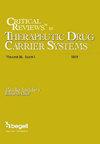Recent Advancements in Electrospun Nanofibers for Wound Healing: Polymers, Clinical and Regulatory Perspective.
IF 3
4区 医学
Q2 PHARMACOLOGY & PHARMACY
Critical Reviews in Therapeutic Drug Carrier Systems
Pub Date : 2022-01-01
DOI:10.1615/critrevtherdrugcarriersyst.2022039840
引用次数: 8
Abstract
Wound management is an unmet therapeutic challenge and a global healthcare burden. Current treatment strategies provide limited efficiency in wound management, thus undergoing constant evolution in the treatment approaches. As wound healing is a complex physiological process involving precise synchronization of various phases like hemostasis, inflammation and remodelling, which necessitates innovative treatment strategies. Nanotechnology platforms like polymeric nanofibers (NFs) offer a promising solution for wound management. NFs contain a porous mesh-like structure that mimics the natural extracellular matrix and promote the cell adhesion and proliferation in the wound bed, thus displaying a great potential as a wound healing scaffold. Electrospinning is a simple, versatile and scalable technique for producing highly porous and tuneable NFs with a high surface area. Electrospun NFs are presenting extensive application in wound management, especially for burns and diabetic foot ulcers. This review briefly discusses the wound physiology and conventional treatment strategies. It also provides an overview of the electrospinning process and its principle, highlighting the application of electrospun polymeric NFs in wound management. The authors have made an attempt to emphasizes on the clinical challenges and future perspectives along with regulatory aspects of NFs as a wound dressing.用于伤口愈合的电纺纳米纤维的最新进展:聚合物、临床和调控观点。
伤口管理是一个尚未解决的治疗挑战和全球卫生保健负担。目前的治疗策略提供了有限的效率,在伤口管理,因此在不断发展的治疗方法。由于伤口愈合是一个复杂的生理过程,包括止血、炎症和重建等各个阶段的精确同步,因此需要创新的治疗策略。聚合物纳米纤维(NFs)等纳米技术平台为伤口管理提供了一个很有前途的解决方案。NFs含有多孔网状结构,可以模拟天然细胞外基质,促进细胞在创面中的粘附和增殖,因此作为创面愈合支架具有很大的潜力。静电纺丝是一种简单、通用和可扩展的技术,用于生产具有高表面积的高多孔性和可调谐的纳米纤维。静电纺纳米纤维在伤口管理中有广泛的应用,特别是在烧伤和糖尿病足溃疡方面。本文就创伤生理及常规治疗策略作一综述。综述了静电纺丝工艺及其原理,重点介绍了静电纺丝聚合物纳米纤维在伤口管理中的应用。作者试图强调临床挑战和未来的观点,以及nf作为伤口敷料的监管方面。
本文章由计算机程序翻译,如有差异,请以英文原文为准。
求助全文
约1分钟内获得全文
求助全文
来源期刊
CiteScore
5.50
自引率
18.50%
发文量
27
审稿时长
>12 weeks
期刊介绍:
Therapeutic uses of a variety of drug carrier systems have significant impact on the treatment and potential cure of many chronic diseases, including cancer, diabetes mellitus, psoriasis, parkinsons, Alzheimer, rheumatoid arthritis, HIV infection, infectious diseases, asthma, and drug addiction. Scientific efforts in these areas are multidisciplinary, involving the physical, biological, medical, pharmaceutical, biological materials, and engineering fields.
Articles concerning this field appear in a wide variety of journals. With the vast increase in the number of articles and the tendency to fragment science, it becomes increasingly difficult to keep abreast of the literature and to sort out and evaluate the importance and reliability of the data, especially when proprietary considerations are involved. Abstracts and noncritical articles often do not provide a sufficiently reliable basis for proper assessment of a given field without the additional perusal of the original literature. This journal bridges this gap by publishing authoritative, objective, comprehensive multidisciplinary critical review papers with emphasis on formulation and delivery systems. Both invited and contributed articles are subject to peer review.

 求助内容:
求助内容: 应助结果提醒方式:
应助结果提醒方式:


